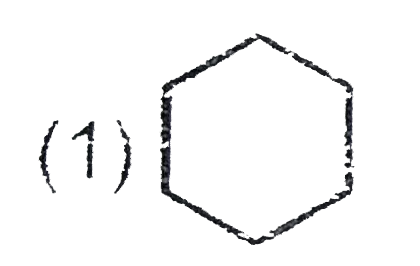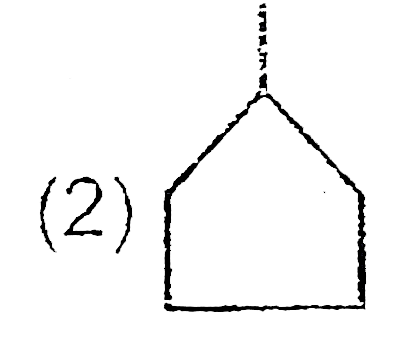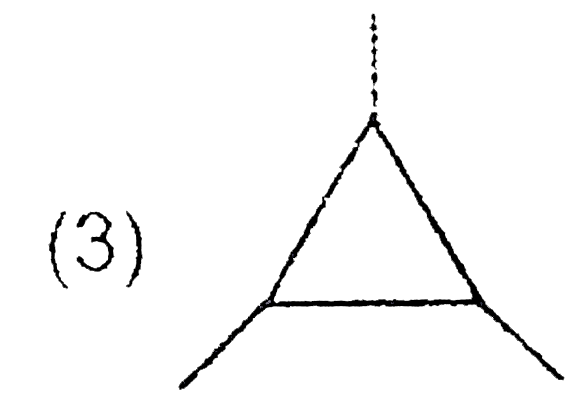Compound A C6H12 forms two monochloro isomers on photochemical chlorination. Its structure can be :




The correct Answer is:C
To solve the problem of identifying the structure of compound A (C₆H₁₂) that forms two monochloro isomers upon photochemical chlorination, we can follow these steps:
Step 1: Determine the Degree of Unsaturation
The molecular formula C₆H₁₂ indicates that the compound is likely a saturated hydrocarbon (alkane) or has some degree of unsaturation (like a ring or double bond). The degree of unsaturation can be calculated using the formula:
Degree of Unsaturation=(2C+2−H)2
For C₆H₁₂:
Degree of Unsaturation=(2×6+2−12)2=22=1
This indicates that there is one degree of unsaturation, which could be a ring or a double bond.
Step 2: Identify Possible Structures
Since there is one degree of unsaturation, we can consider structures that are either cyclic or contain a double bond. The simplest structures to consider are cycloalkanes or alkenes.
1. Cyclohexane (C₆H₁₂): A six-membered ring with no double bonds.
2. Alkenes: For example, 1-hexene or 2-hexene, but these typically yield more than two monochloro products due to multiple positions for substitution.
Step 3: Analyze Chlorination of Cyclohexane
Let’s analyze cyclohexane (C₆H₁₂):
- Cyclohexane has 12 hydrogen atoms, and upon chlorination, the chlorine can replace hydrogen atoms.
- The hydrogen atoms can be classified based on their positions:
- All hydrogen atoms on the ring are equivalent due to symmetry, leading to the formation of only one monochloro product.
Step 4: Analyze Chlorination of Methylcyclopentane
Next, let’s consider methylcyclopentane:
- This compound has a five-membered ring with one methyl group attached.
- The hydrogens can be classified as:
- Primary hydrogens (on the methyl group)
- Secondary hydrogens (on the ring)
- Tertiary hydrogens (adjacent to the methyl group)
When chlorinating methylcyclopentane:
1. Chlorination at the primary position yields one isomer.
2. Chlorination at the tertiary position yields another isomer.
3. Chlorination at the secondary positions does not yield new isomers due to symmetry.
Step 5: Conclusion
From the analysis, we conclude that methylcyclopentane (C₆H₁₂) is a suitable candidate that yields exactly two monochloro isomers upon chlorination.
Final Answer
The structure of compound A (C₆H₁₂) that forms two monochloro isomers on photochemical chlorination is methylcyclopentane.
The molecular formula C₆H₁₂ indicates that the compound is likely a saturated hydrocarbon (alkane) or has some degree of unsaturation (like a ring or double bond). The degree of unsaturation can be calculated using the formula:
Degree of Unsaturation=(2C+2−H)2
For C₆H₁₂:
Degree of Unsaturation=(2×6+2−12)2=22=1
This indicates that there is one degree of unsaturation, which could be a ring or a double bond.
Since there is one degree of unsaturation, we can consider structures that are either cyclic or contain a double bond. The simplest structures to consider are cycloalkanes or alkenes.
2. Alkenes: For example, 1-hexene or 2-hexene, but these typically yield more than two monochloro products due to multiple positions for substitution.
Let’s analyze cyclohexane (C₆H₁₂):
- Cyclohexane has 12 hydrogen atoms, and upon chlorination, the chlorine can replace hydrogen atoms.
- The hydrogen atoms can be classified based on their positions:
- All hydrogen atoms on the ring are equivalent due to symmetry, leading to the formation of only one monochloro product.
Next, let’s consider methylcyclopentane:
- This compound has a five-membered ring with one methyl group attached.
- The hydrogens can be classified as:
- Primary hydrogens (on the methyl group)
- Secondary hydrogens (on the ring)
- Tertiary hydrogens (adjacent to the methyl group)
1. Chlorination at the primary position yields one isomer.
2. Chlorination at the tertiary position yields another isomer.
3. Chlorination at the secondary positions does not yield new isomers due to symmetry.
From the analysis, we conclude that methylcyclopentane (C₆H₁₂) is a suitable candidate that yields exactly two monochloro isomers upon chlorination.
The structure of compound A (C₆H₁₂) that forms two monochloro isomers on photochemical chlorination is methylcyclopentane.
Topper's Solved these Questions
- BOOK - RESONANCE ENGLISHCHAPTER - STRUCTURAL IDENTIFICATIONEXERCISE - Advanced level Problems (Part-II)21videos
STRUCTURAL IDENTIFICATION
- BOOK - RESONANCE ENGLISHCHAPTER - STRUCTURAL IDENTIFICATIONEXERCISE - Advanced level Problems (Part-III)12videos
STRUCTURAL IDENTIFICATION
- BOOK - RESONANCE ENGLISHCHAPTER - STRUCTURAL IDENTIFICATIONEXERCISE - Exercise-3 Jee (Advanced) (Part-II)15videos
STRUCTURAL IDENTIFICATION
- BOOK - RESONANCE ENGLISHCHAPTER - STEREOISOMERISMEXERCISE - EXERCISE (PART III : PRACTICE TEST-2 (IIT-JEE (ADVANCED PATTERN))23videos
STEREOISOMERISM
- BOOK - RESONANCE ENGLISHCHAPTER - SURFACE CHEMISTRYEXERCISE - Section - 51videos
SURFACE CHEMISTRY
Similar Questions
Knowledge Check
- Question 1 - Select One
An alkane C6H14 gives two monochloro derivatives on chlorination. Its possible structure is
ACH3CH2CH2CH2CH2CH3BCH3−C∣CH3H−CH2CH2CH3CCH3−C∣CH2CH3H−CH2CH3DCH3−CH3∣CH−CH3∣CH−CH3
Among the isomeric alkanes formula C5H12, identify the one that on photochemical chlorination yields only monochloro derivative.
View SolutionRead the following passage carefully and answer the questions :
CH2=CH−C∣H1C=C∣CH3−CH=CH2 ,
How many total monochloro structure isomers obtained on chlorination of product (N).View SolutionAmong the isomeric alkanes of molecular formula C5H12, identify the one that on photochemical chlorination yields
(i) A single monochloride.
(ii) Three isomeric monochlorides.
(iii) Four isomeric monochlorides.View SolutionName the gas evolved when: Ammonium carbonate undergoes thermal decomposition
View SolutionName the gas evolved when: Calcium nitrate undergoes thermal decomposition
View SolutionAmong the isomeric alkanes of molecular formula C5H12, identify the one that on photochemical chlorination yields
(i) A single monochloride.
(ii) Three isomeric monochlorides.
(iii) Four isomeric monochlorides.View SolutionAmong the isomeric alkanes of molecular formula C5H12, identify the one that on photochemical chlorination yields
(i) A single monochloride.
(ii) Three isomeric monochlorides.
(iii) Four isomeric monochlorides.View Solution


